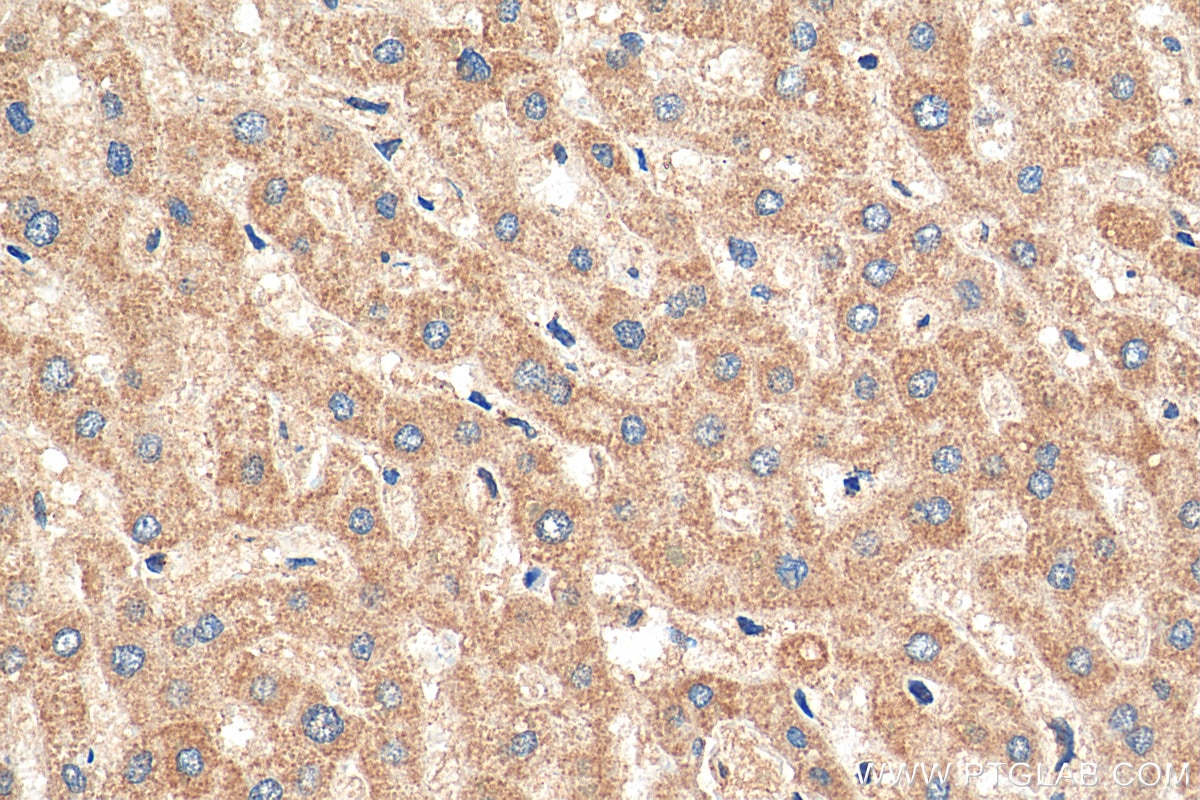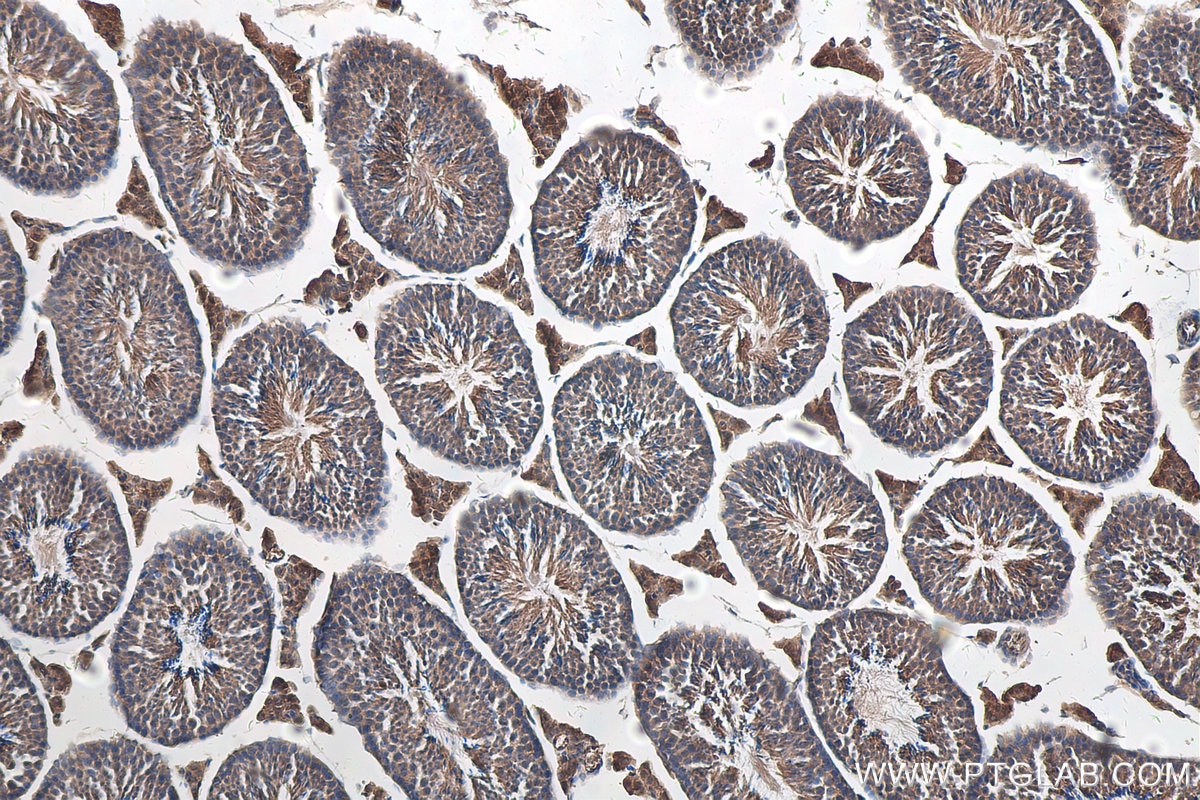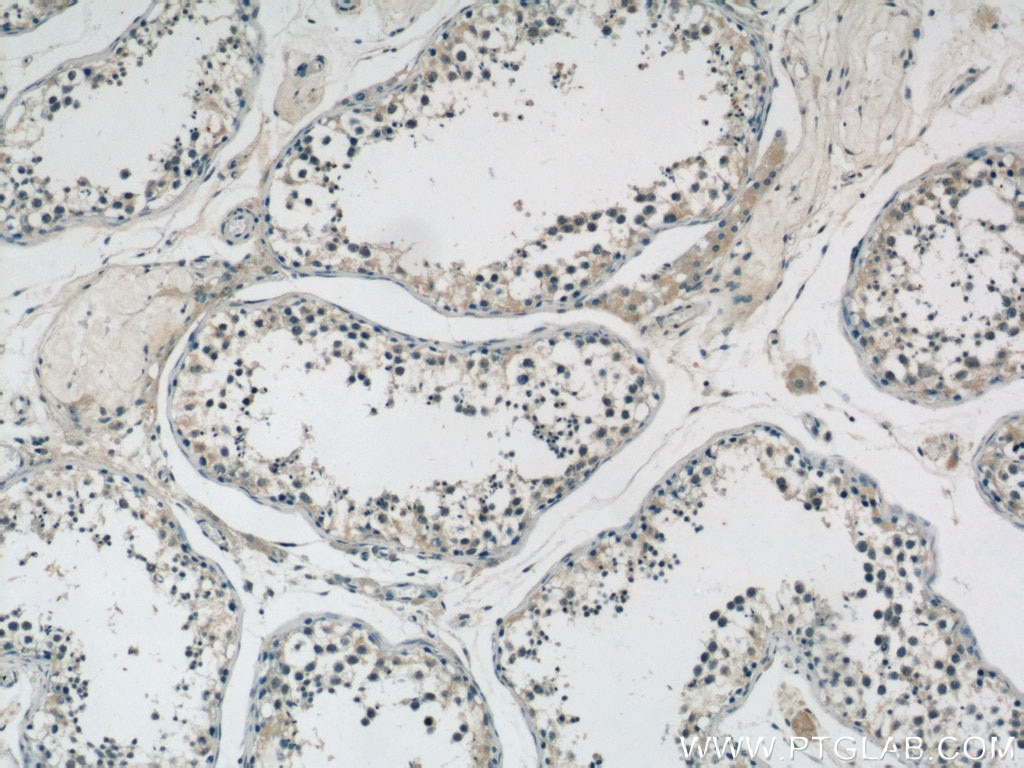- Phare
- Validé par KD/KO
Anticorps Polyclonal de lapin anti-MTIF3
MTIF3 Polyclonal Antibody for WB, IP, IHC, ELISA
Hôte / Isotype
Lapin / IgG
Réactivité testée
Humain, souris et plus (1)
Applications
WB, IP, IHC, ELISA
Conjugaison
Non conjugué
N° de cat : 14219-1-AP
Synonymes
Galerie de données de validation
Applications testées
| Résultats positifs en WB | cellules A431, cellules HeLa, cellules HepG2, cellules HT-29 |
| Résultats positifs en IP | cellules HeLa |
| Résultats positifs en IHC | tissu hépatique humain, tissu testiculaire de souris, tissu testiculaire humain il est suggéré de démasquer l'antigène avec un tampon de TE buffer pH 9.0; (*) À défaut, 'le démasquage de l'antigène peut être 'effectué avec un tampon citrate pH 6,0. |
Dilution recommandée
| Application | Dilution |
|---|---|
| Western Blot (WB) | WB : 1:500-1:2000 |
| Immunoprécipitation (IP) | IP : 0.5-4.0 ug for 1.0-3.0 mg of total protein lysate |
| Immunohistochimie (IHC) | IHC : 1:50-1:500 |
| It is recommended that this reagent should be titrated in each testing system to obtain optimal results. | |
| Sample-dependent, check data in validation data gallery | |
Applications publiées
| WB | See 7 publications below |
Informations sur le produit
14219-1-AP cible MTIF3 dans les applications de WB, IP, IHC, ELISA et montre une réactivité avec des échantillons Humain, souris
| Réactivité | Humain, souris |
| Réactivité citée | rat, Humain, souris |
| Hôte / Isotype | Lapin / IgG |
| Clonalité | Polyclonal |
| Type | Anticorps |
| Immunogène | MTIF3 Protéine recombinante Ag5457 |
| Nom complet | mitochondrial translational initiation factor 3 |
| Masse moléculaire calculée | 32 kDa |
| Poids moléculaire observé | 29 kDa |
| Numéro d’acquisition GenBank | BC046166 |
| Symbole du gène | MTIF3 |
| Identification du gène (NCBI) | 219402 |
| Conjugaison | Non conjugué |
| Forme | Liquide |
| Méthode de purification | Purification par affinité contre l'antigène |
| Tampon de stockage | PBS avec azoture de sodium à 0,02 % et glycérol à 50 % pH 7,3 |
| Conditions de stockage | Stocker à -20°C. Stable pendant un an après l'expédition. L'aliquotage n'est pas nécessaire pour le stockage à -20oC Les 20ul contiennent 0,1% de BSA. |
Informations générales
MTIF3, also named as DC38, belongs to the IF-3 family. MTIF3 encodes a 29 kDa protein that promotes formation of the initiation complex on the mitochondrial 55S ribosome, thereby playing an active role in initiation of translation. Like bacterial IF3, MTIF3 is believed to bind first to the small mitoribosomal subunit to keep it dissociated from the large subunit during initiation. After binding of MTIF3, mRNA and formylated initiator methionyl-tRNA (fMet-tRNAifMet) bind to the small mitoribosomal subunit. The large subunit then joins the small subunit to form an elongation-competent ribosome (PMID:20887776, 31350787).
Protocole
| Product Specific Protocols | |
|---|---|
| WB protocol for MTIF3 antibody 14219-1-AP | Download protocol |
| IHC protocol for MTIF3 antibody 14219-1-AP | Download protocol |
| IP protocol for MTIF3 antibody 14219-1-AP | Download protocol |
| Standard Protocols | |
|---|---|
| Click here to view our Standard Protocols |
Publications
| Species | Application | Title |
|---|---|---|
Sci Adv Fidelity of translation initiation is required for coordinated respiratory complex assembly. | ||
EMBO J Stress signaling and cellular proliferation reverse the effects of mitochondrial mistranslation. | ||
Sci Rep Initiation Factor 3 is Dispensable For Mitochondrial Translation in Cultured Human Cells. | ||
Sci Total Environ Fluoride impairs mitochondrial translation by targeting miR-221-3p/c-Fos/RMND1 axis contributing to neurodevelopment defects | ||
Elife Identification of a weight loss-associated causal eQTL in MTIF3 and the effects of MTIF3 deficiency on human adipocyte function |
Avis
The reviews below have been submitted by verified Proteintech customers who received an incentive forproviding their feedback.
FH Mi (Verified Customer) (02-10-2023) | It works pretty well! We tried different antibodies from other suppliers, and this one gives a specific band, as we expected from the knockout samples. Although, we did observe some non-specific bands, having a knockout control would validate the target band.
|










